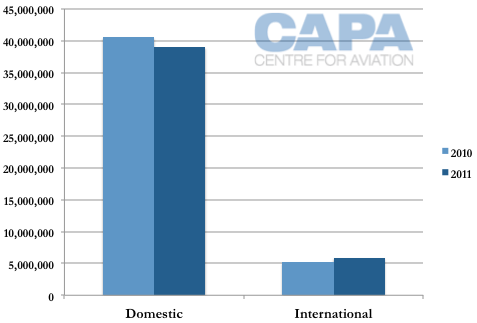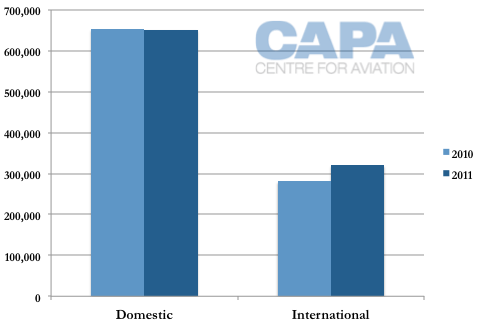All Nippon Airways would invest in airlines as part of strategy to counter Japan's declining economy
The impact on airlines of declining economies is being felt swiftly and sharply in Europe, where the fortunate face drastic measures and the unfortunate go out of business. Those that weather the storm are promised with an eventual upturn, but in Japan the situation is different where its decline is very gradual but with a shrinking economy, slowing birthrate and ageing population; Europe's challenge is cyclical if extreme but Japan's offers no guaranteed rebound.
So the challenge to its airlines is creating a structural change of business. All Nippon Airways (ANA), the country's largest carrier, has created a three-pronged strategy, the last of which is still surprising: ANA would seek to invest in foreign carriers, joining a small club of airline investors. It is something of an Armageddon day strategy, targeting overseas markets when or if its own home market is no longer enough. There is no timeframe or specific target within Asia, but ANA would seek an airline that would help it achieve 8% ROA and 10% ROE.
ANA's strength is in the domestic Japanese market
Air transport accounted for 88% of ANA's revenue in FY2011, or JPY1262.5 billion (USD15.2 billion). Travel services accounted for the remainder. Domestic revenue accounts for 52% of air transport revenue, or JPY651.5 billion (USD7.8 billion), as well as 46% of all revenue at ANA. While ANA does not disclose margins or profits, the domestic market is considerably more profitable than the international market.
ANA passengers carried, international/domestic breakdown: FY2010 to FY2011
ANA passenger revenue breakdown (in millions of JPY): FY2011
By seeking to invest in foreign carriers, ANA looks for new markets
ANA's concern is that its home market of Japan may shrink to the point that to maintain growth and profit it needs to access new home markets. ANA, speaking at its 2QFY2012 results, said its guiding approach is to see how much revenue a carrier it invests in can flow back to ANA. Also key factors are, as would be expected, the size of the investment as well as future opportunities and risks. But ANA is also interested how a receiving airline could complement or link up to its existing operations; ANA is looking for network benefits as much as profit. ANA has not said how many carriers it would invest in, and there seem to be hints it may look at aviation-related businesses. Airlines may be high-profile but they are low on margins.
ANA would consider opportunities to invest in full service carriers or low-cost carriers, or expand its existing operation. In addition to ANA mainline, ANA has stakes in AirAsia Japan and Peach, two of the three LCCs that launched in Japan in 2012.
For investments in full service carriers, ANA is venturing into relatively untested waters. LCCs are well under way at establishing joint ventures to have new home markets, but LCCs typically have an offering that is more universal - the cheapest ticket - than a full service carrier that relies on branding, frequent flyer programmes and often national sentiment. The Virgin Group has active Virgin carriers as well as others it has planned, and while there are some shared characteristics from a passenger experience point of view, as businesses they tend to be quite different with limited connections between them.
Likewise China's HNA Group has stakes in carriers in France and Ghana, and proposals elsewhere, but those situations are either for very specific reasons (for France, HNA is effectively unable to fly between China and France with a Chinese AOC) or strategies that are not yet evident (Ghana).
In Latin America the LAN as well as Avianca-TACA groups have established full service carriers elsewhere, although this was largely made possible by nascent LCC coverage as well as absent, or ineffective, full service carriers.
A guiding example for ANA may be a combination of the LAN, Avianca-TACA and Etihad models. Etihad has taken stakes globally in Aer Lingus, Air Seychelles, airberlin and Virgin Australia. Etihad's pursuit is more connecting traffic and bilateral access than establishing its brand in a new home market (as LAN, Avianca-TACA and LCCs have done).
See related report: Revitalised Air Seychelles looks to use Hong Kong as Asian hub and proxy service for Etihad
ANA can bring cash but less so on intellectual property and know-how
ANA in 2012 raised equity, which it said would fund future aircraft purchases as well as any equity stakes, although some wonder if the move - around the time of rival Japan Airlines' re-listing on the Tokyo stock exchange - was more to steal JAL's limelight. Nonetheless, ANA can bring to an airline cash - but perhaps little else. ANA acknowledges its direct operation cannot be exported. Although it speaks of know-how and processes it has accumulated, their use internationally would have limits; Japan like much of North Asia has been a stagnating, not innovative, market. Costs are high, a reflection of fixed costs but also not seeking to cut them down.
The experience of ANA in establishing LCC Peach was that Peach's cost base became inflated as it inherited legacy ANA practices. AirAsia Japan in comparison made a far greater effort to stay at arm's length from ANA, as did Jetstar Japan with partner JAL. Incidentally, the market favours Jetstar Japan because of how little involvement there is from JAL, which had billions in debt before filing for bankruptcy.
LCCs like AirAsia and Jetstar bring considerable intellectual property in terms of making airlines more efficient, but ANA has few such comparisons to bring to the table.
ANA speaks of likely wanting to take a role in management of a carrier it invests in, but even with a minority non-controlling interest, its day-to-day benefits are not immediately clear.
Europe is a buyer's market - but Asia not so
Turkish Airlines in 2012 garnered attention when it announced it wanted to acquire stakes in European airlines. (An advanced proposal involving LOT fell through due to EU ownership statutes that apparently were not given due diligence.) Then, as now, Europe was a buyer's market with far more floundering carriers than those willing to invest.
Asia is a different story. Major carriers are confident of their positions or heavily linked to the state while smaller ones may face an uncertain future or are in environments where foreign investment has proved convoluted (as occurred with Jetstar Pacific in Vietnam, and Singapore Airlines' failed investment attempt in China Eastern). Most carriers will be weary of any hints of being told what to do - especially by foreigners. China has a large outbound market that could mesh well with ANA's network (although ANA is far more costly than Chinese carriers or the Korean carriers that are doing well targeting sixth freedom traffic from China), but Chinese ownership is sensitive, and the recent territorial dispute between China and Japan will ensure that resentment lingers.
So match mates for ANA are not clear. ASEAN could be of interest, not only because of its high growth rates, but - as ANA notes - open skies agreements commencing from 2015. That is from a strategic point of view; financially, ownership limitations are the norm.
There is room for ANA to partake in LCC expansion, but this comes with its own challenges
Expanding via LCCs is more versatile but not without challenges. Although ANA has two LCCs, neither are fully its own. Expansion would likely have to be done with existing shareholders in the case of Peach while the AirAsia Group, which invests in AirAsia Japan with ANA, can grow further without ANA, and indeed there are likely limits on AirAsia Japan's growth independent of AirAsia influence.
Depending where ANA goes, it may need to carefully balance partnerships. LCC expansion could compete against other interests from AirAsia or shareholders in Peach. Its full service carrier partnerships across Asia are limited, but expansion on another Star Alliance carrier's home market would rattle feathers.
Expansion of international markets and fostering of LCCs are core strategies
ANA moving to new markets is the riskiest of its strategies and also the option of last resort. Its first two strategies are already being well implemented. First is for ANA to access greater international markets. It is expanding across Asia, such as to Myanmar, but a focus is on long-haul routes, an endeavour tied to ANA's large purchase of 787 Dreamliners. ANA is boosting frequency on destinations like to New York while opening new destinations, such as San Jose and Seattle. Additional expansion, in the United States and in new markets, is all but certain.
ANA's second initiative is to grow via low-cost carriers, a proposition it mulled for years but became serious about only in the last two to three. ANA first launched Peach, which first flew in Mar-2012, and in Aug-2011 became involved in AirAsia Japan, which launched in Aug-2012. There is currently no overlap between Peach and AirAsia Japan but this will likely change with AirAsia Japan, based at Tokyo Narita, entering Peach's base at Osaka Kansai in the near future. There will be tension, but the overriding view for this convoluted strategy is that if ANA had not partaken in AirAsia Japan, Japanese competitor Skymark would have, so it was better for ANA to become involved in both and mitigate overlap than let one of its carriers be cannibalised by a competitor.
Important to recognise need for change, but how will an investment play out?
While big picture elements remain to be worked out, to say the least of details, ANA exhibits confidence in recognising the need to change and in some instances take radical steps to do so. This is not a given anywhere, especially with legacy carriers. It is an important first step, but only the beginning of an arduous process if ANA is serious in investing and finds a suitable partner.

